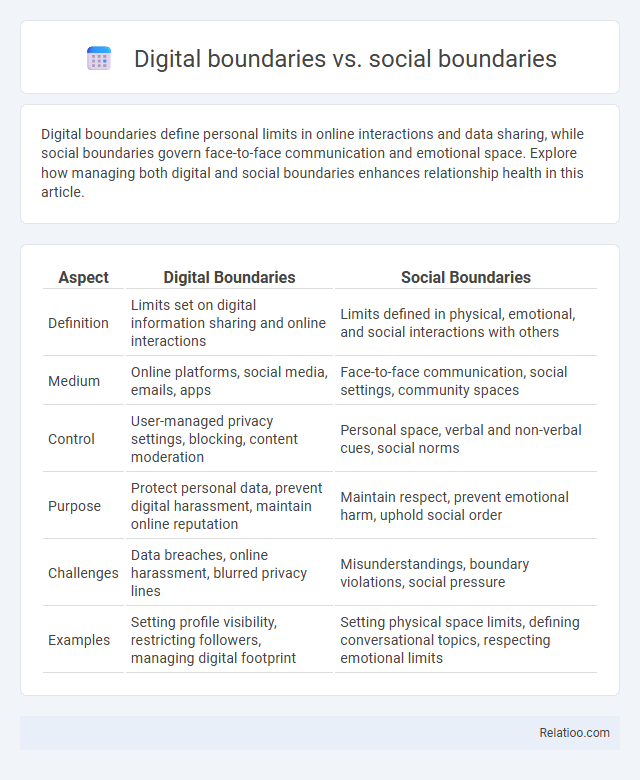Digital boundaries define personal limits in online interactions and data sharing, while social boundaries govern face-to-face communication and emotional space. Explore how managing both digital and social boundaries enhances relationship health in this article.
Table of Comparison
| Aspect | Digital Boundaries | Social Boundaries |
|---|---|---|
| Definition | Limits set on digital information sharing and online interactions | Limits defined in physical, emotional, and social interactions with others |
| Medium | Online platforms, social media, emails, apps | Face-to-face communication, social settings, community spaces |
| Control | User-managed privacy settings, blocking, content moderation | Personal space, verbal and non-verbal cues, social norms |
| Purpose | Protect personal data, prevent digital harassment, maintain online reputation | Maintain respect, prevent emotional harm, uphold social order |
| Challenges | Data breaches, online harassment, blurred privacy lines | Misunderstandings, boundary violations, social pressure |
| Examples | Setting profile visibility, restricting followers, managing digital footprint | Setting physical space limits, defining conversational topics, respecting emotional limits |
Understanding Digital Boundaries: Definition and Importance
Digital boundaries refer to the limits you set on sharing personal information and managing interactions in online spaces, distinguishing them from social boundaries that govern face-to-face relationships and traditional social contexts. Understanding digital boundaries is crucial for protecting your privacy, maintaining control over your digital footprint, and preventing cyberbullying or exploitation. Establishing clear digital boundaries empowers you to navigate the online world safely, ensuring that your personal data and emotional well-being are respected.
Defining Social Boundaries in Today’s Society
Defining social boundaries in today's society involves understanding the unwritten rules and norms governing interpersonal interactions both online and offline, which shape personal space, privacy, and acceptable behavior. Digital boundaries specifically refer to the limits individuals set regarding their online presence, communication, and data sharing to protect their digital identity and maintain control over virtual interactions. Unlike purely social boundaries driven by cultural and contextual factors, digital boundaries emphasize cybersecurity, data privacy, and the management of digital footprints in an increasingly connected world.
Key Differences Between Digital and Social Boundaries
Digital boundaries define the limits you set on your online interactions and data sharing, emphasizing control over privacy, security, and digital footprint. Social boundaries focus on interpersonal limits within real-world relationships, highlighting emotional space, respect, and acceptable behavior. Understanding the key differences between digital and social boundaries helps you manage your interactions effectively by distinguishing virtual privacy from face-to-face personal limits.
The Impact of Technology on Boundary Formation
Technology significantly influences the formation of digital, social, and digital boundaries by reshaping how personal and professional interactions occur. Digital boundaries define the limits You set online to control information sharing, while social boundaries regulate face-to-face relationships and emotional space. The constant connectivity enabled by technology blurs these boundaries, challenging individuals to maintain balance between privacy, communication, and social expectations.
Navigating Privacy in the Digital Age
Digital boundaries define the limits you set on your online presence, controlling access to personal data and digital interactions, while social boundaries regulate how you engage with others in both virtual and physical spaces. Navigating privacy in the digital age requires understanding the overlap between these boundaries to protect your information from unauthorized exposure or misuse. Clear distinctions between digital and social boundaries empower you to manage relationships and data-sharing effectively across diverse communication platforms.
Social Norms and Etiquette in Online vs. Offline Spaces
Digital boundaries define acceptable behavior and privacy in online spaces, while social boundaries govern interactions and respect in offline environments; your awareness of these distinctions ensures appropriate conduct. Social norms and etiquette vary significantly between digital platforms and physical settings, requiring adaptation to context-specific rules such as online privacy controls versus face-to-face communication cues. Understanding these differences helps you navigate both digital and social boundaries effectively, fostering respectful and meaningful interactions.
Managing Relationships: Digital vs. In-Person Interactions
Managing relationships requires understanding the distinct nature of digital boundaries versus social boundaries, as digital interactions often lack nonverbal cues present in in-person communication. Your ability to navigate digital boundaries involves setting clear limits on online availability and privacy, while social boundaries emphasize respect, trust, and emotional connection in face-to-face settings. Balancing these boundaries ensures healthier relationships by adapting communication styles to fit both digital platforms and real-world social contexts.
Challenges to Maintaining Healthy Boundaries
Maintaining healthy digital boundaries involves addressing challenges such as constant accessibility, oversharing, and blurred lines between personal and professional life, which can cause stress and burnout. Social boundaries demand managing expectations around time, emotional energy, and privacy, often complicated by cultural differences and interpersonal dynamics. Your ability to differentiate and enforce these boundaries is crucial for mental well-being and fostering respectful interactions across both digital and social environments.
Strategies for Setting and Enforcing Digital Boundaries
Effective strategies for setting and enforcing digital boundaries include clearly defining personal and professional online limits to prevent burnout and protect privacy. Utilizing privacy settings, scheduling designated offline times, and communicating expectations with digital contacts reinforce these boundaries. Integrating these approaches helps distinguish digital boundaries from broader social boundaries, ensuring a balanced, respectful interaction in virtual environments.
The Future of Boundaries: Evolving with Digital Transformation
Digital boundaries define how your personal data and online interactions are protected, while social boundaries govern interpersonal relationships and acceptable behavior in social contexts. The future of boundaries will increasingly blend these concepts as digital transformation reshapes communication, raising the need for adaptive rules that balance privacy, trust, and connectivity. Your ability to navigate and respect both digital and social boundaries will become critical in maintaining healthy relationships and safeguarding personal information in a digitally driven world.

Infographic: Digital boundaries vs Social boundaries
 relatioo.com
relatioo.com